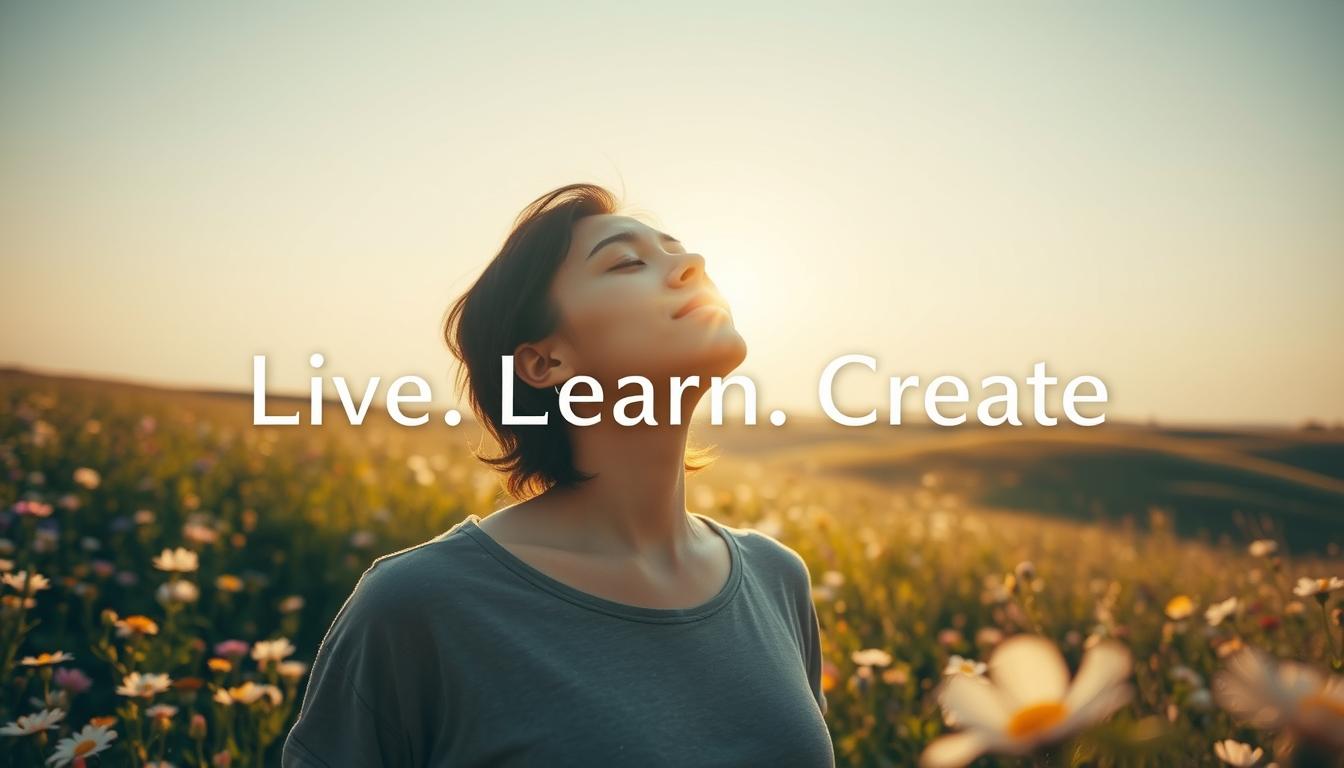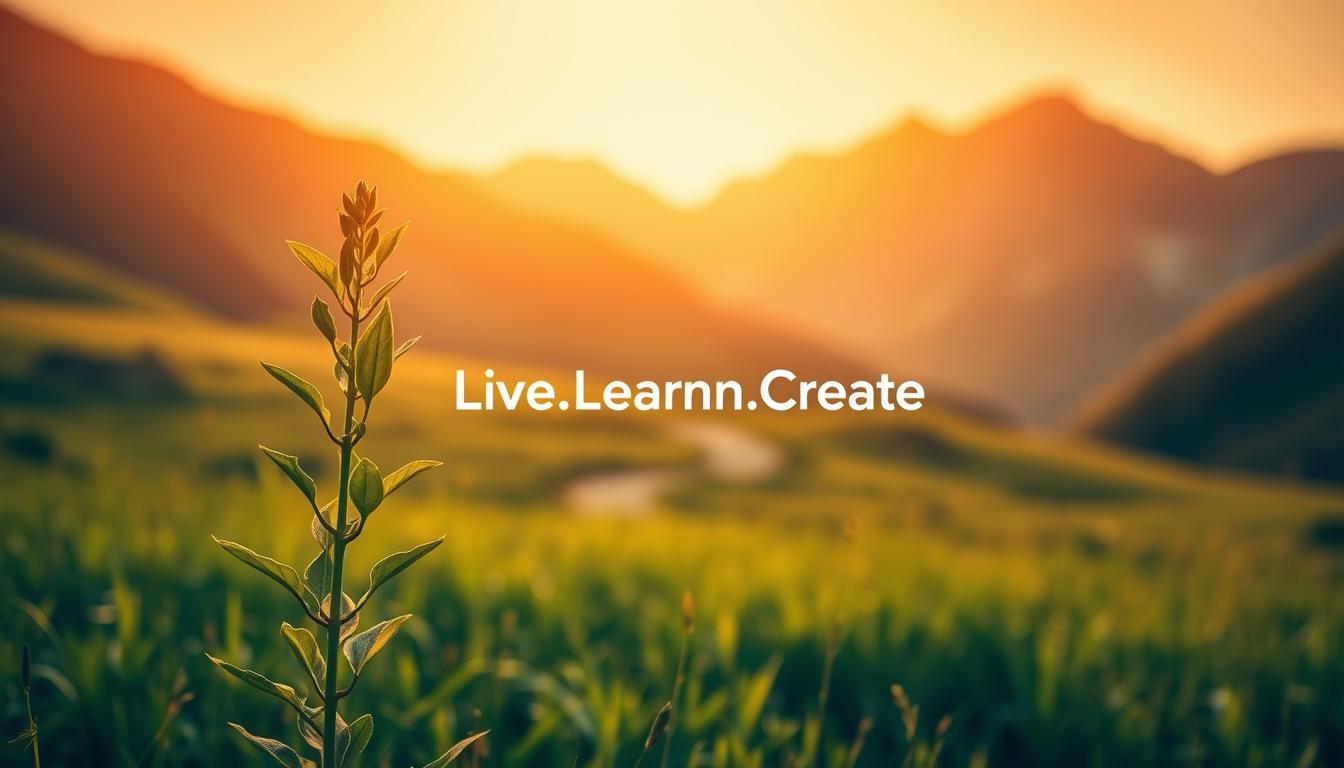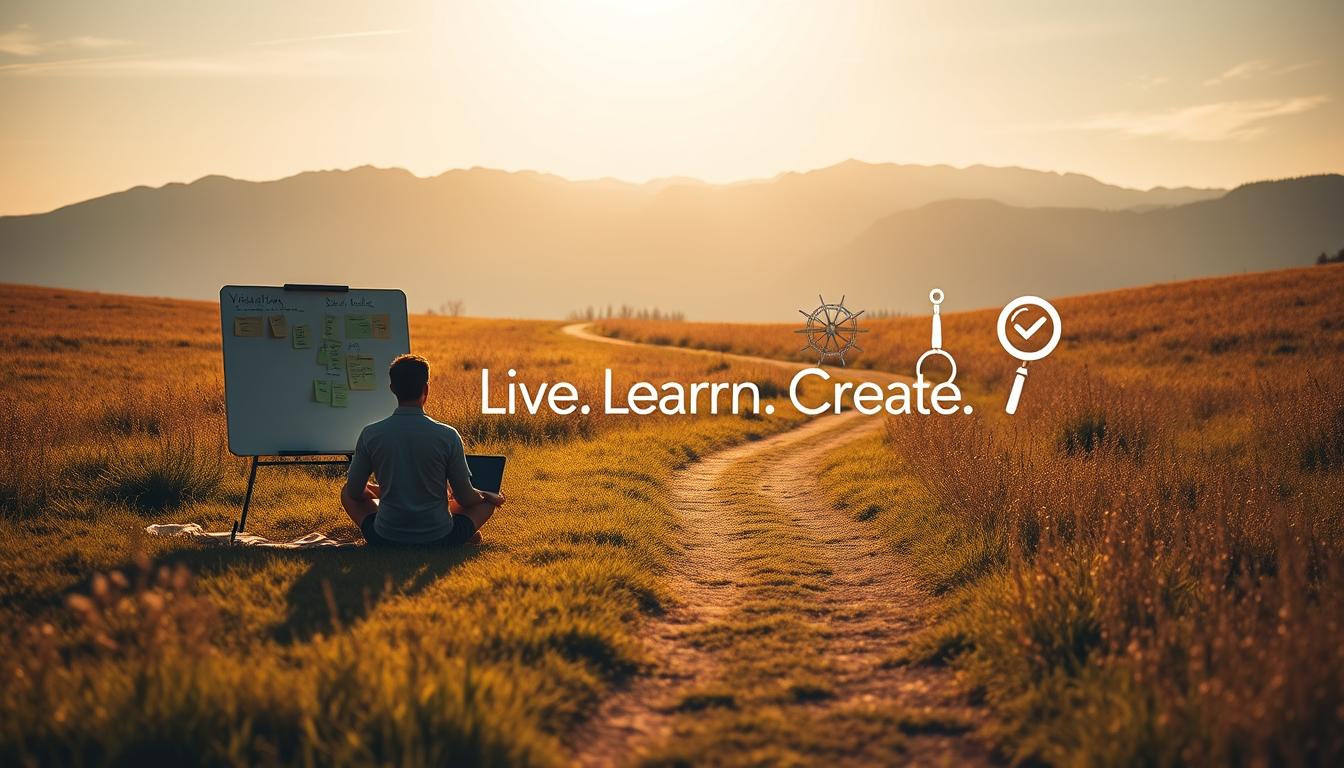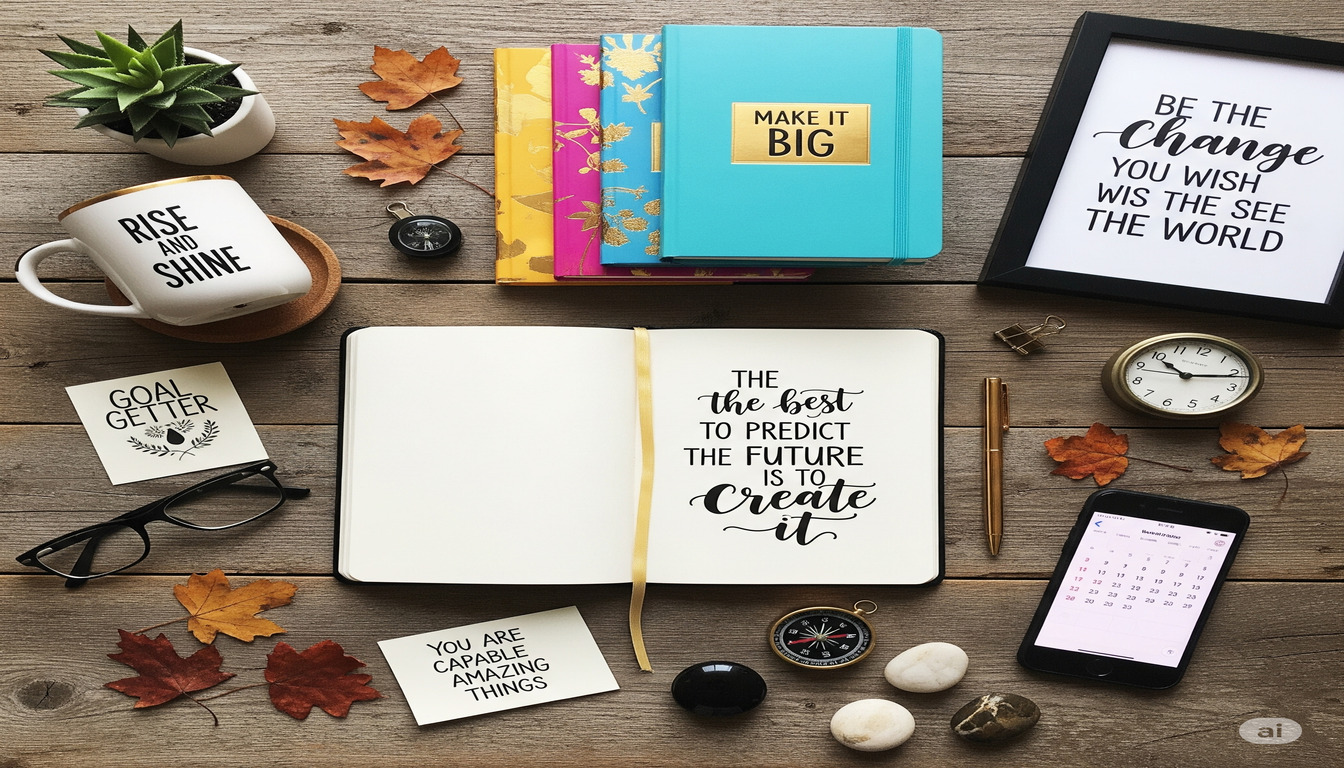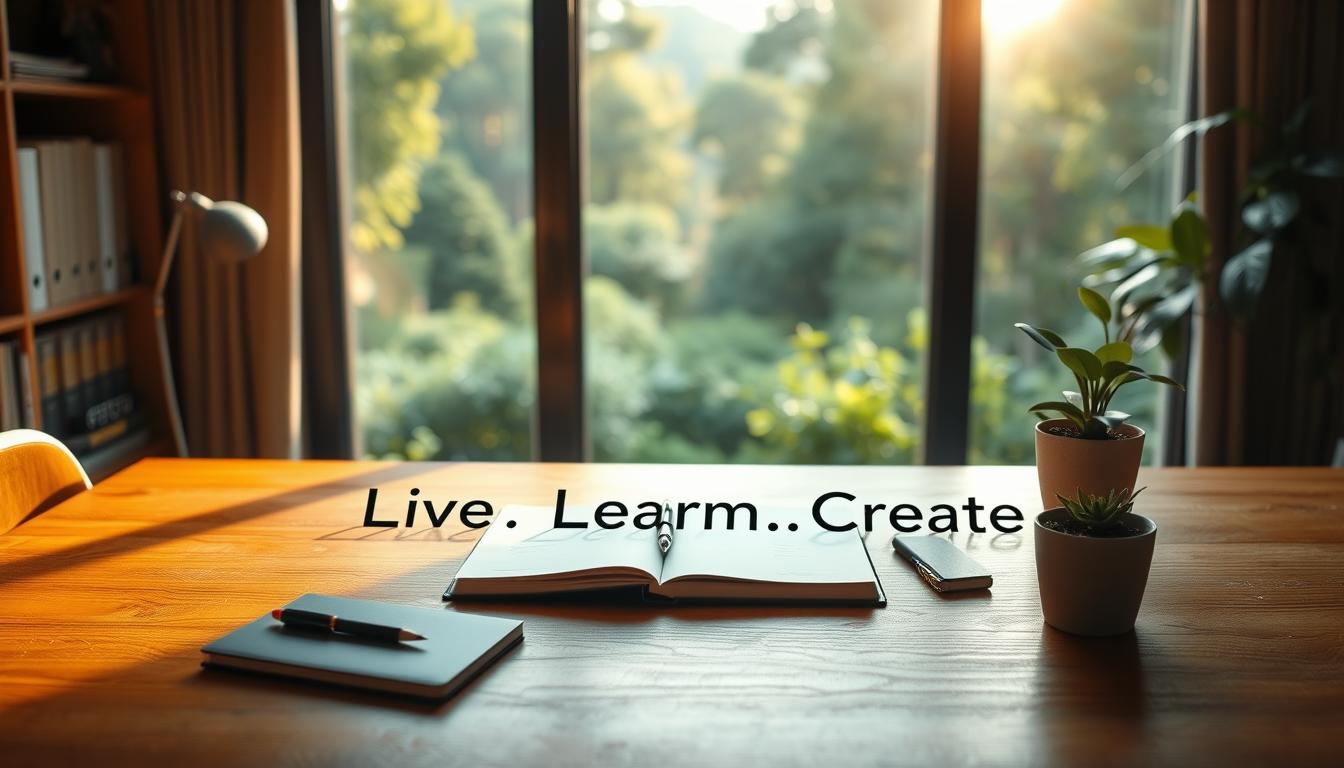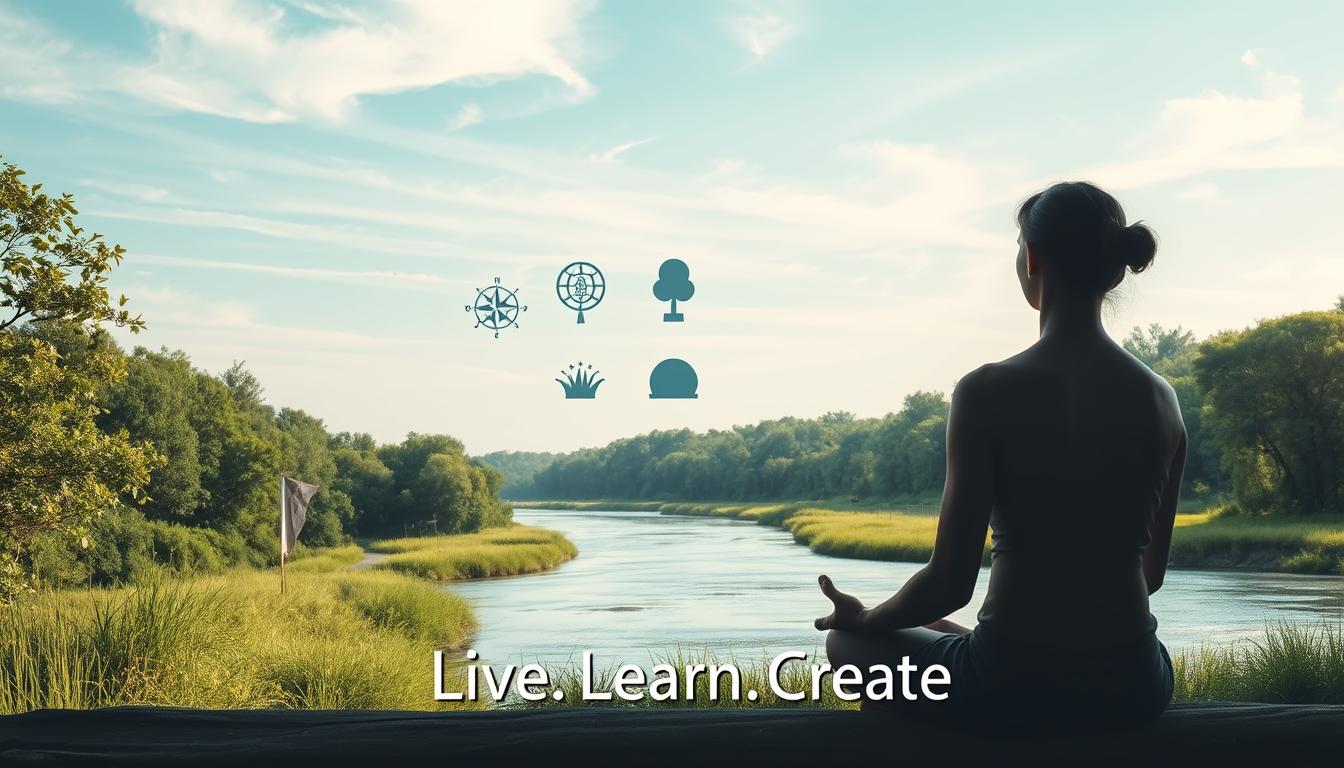Julia Cameron, a famous artist, once said, “Creativity is a sacred gift, but it comes with a vulnerability that can be both a blessing and a curse.” This vulnerability often shows up as a deep fear of being rejected or criticized. It can really take a toll on creatives’ emotions.
When we dive into creativity, we open ourselves up to the risk of failure. Yet, it’s in these moments of vulnerability that we find chances for personal growth and a positive mindset. By facing and understanding the emotional hurdles of creative work, we can build resilience. We also learn to be kinder to ourselves.
If you’re looking for help on this path, check out “The Artist’s Way” by Julia Cameron. You can also find mindfulness journals on amazon.com. They offer great support.
Key Takeaways
- Cultivating a positive mindset is key to handling the emotional side of creativity.
- Personal growth is a big win from facing and learning from rejection and criticism.
- Mindfulness and self-compassion are vital for creatives facing emotional challenges.
- Resources like “The Artist’s Way” and mindfulness journals can offer support.
- Embracing vulnerability can lead to greater resilience and creative fulfillment.
Understanding the Creative Process
The creative process is a personal and emotional journey. It requires vulnerability and courage. As we create, we feel many emotions – from excitement to doubt.
The Emotional Journey of Creativity
Creativity is more than making something new. It’s an emotional journey that can be both rewarding and tough. It involves:
- Embracing uncertainty and the unknown
- Confronting and overcoming self-doubt
- Persevering through criticism and rejection
This journey is unique to each person. It’s shaped by our experiences, fears, and dreams. By understanding these emotions, creatives can improve and achieve their goals.
The Role of Vulnerability in Artistry
Vulnerability is key to true artistry. It lets creatives be open, honest, and innovative. When we are vulnerable, we:
- Allow ourselves to be seen and understood
- Take risks that can lead to breakthroughs
- Connect with others on a deeper level
By embracing vulnerability, artists can reach their full creative power. It’s about being brave enough to share our true selves. This way, we create something truly remarkable.
The Impact of Rejection on Artists
Success often comes after facing many rejections. This is true for artists, who must deal with rejection’s effects on their motivation and well-being.
Why Rejection Feels So Personal
Artists see their work as a part of themselves. When it’s rejected, it feels like a personal attack. This can lead to self-doubt and lower motivation.
Developing a growth mindset can help. Seeing rejection as a chance to learn and grow can protect self-worth. This mindset is key to staying motivated and creating meaningful art.

Common Forms of Rejection in Creative Fields
Artists face many types of rejection, like being turned down by galleries or publishers. They also deal with criticism from peers and audiences. Knowing these common forms helps artists prepare and find ways to cope.
| Form of Rejection | Impact on Artists | Motivation Techniques |
|---|---|---|
| Gallery or Exhibition Rejection | Feeling undervalued, self-doubt | Seek feedback, diversify exhibition spaces |
| Publisher Rejection | Discouragement, fear of failure | Revise and resubmit, explore self-publishing |
| Criticism from Peers or Audience | Hurt, defensiveness | Practice self-compassion, use constructive feedback for growth |
Understanding rejection’s forms and impacts helps artists find ways to stay motivated. A growth mindset is essential for overcoming these challenges and continuing to create.
Building Resilience Through Criticism
The journey to resilience starts with handling criticism well. As creatives, we need to tell constructive feedback apart from negativity. This helps us grow and improve ourselves.
Transforming Criticism into Constructive Feedback
Criticism can be a powerful tool for getting better, if we see it the right way. It’s about changing our view to see feedback as a chance to grow, not as a personal attack. This way, we develop a positive mindset open to learning and growing.
To turn criticism into useful feedback, we must first listen well. It’s not just about hearing words, but understanding what’s behind them. Asking questions and looking for specific examples helps us get the feedback right.
Learning to Separate Personal Worth from Work
One hard part of criticism is not mixing our personal worth with our work. It’s natural to feel it personally, but this can make us defensive and stop us from growing. By keeping our self-worth and work separate, we can handle criticism better.
This separation helps us keep a healthy self-image, even when we get negative feedback. It takes time and effort, but it makes us more resilient and positive.
By accepting criticism and keeping our personal worth separate from our work, we build resilience. We also create a space for personal growth and self-improvement. This journey, though tough, is key to reaching our creative fullness.
The Connection Between Mindset and Motivation
A positive mindset is key to motivation, more so in creative fields. It makes us more open to learning and facing challenges. This openness drives us to reach our goals.

How a Positive Mindset Fuels Creativity
A positive mindset boosts our creativity and motivation. It lets us see tasks in a new light. This openness is vital for creativity.
Carol Dweck’s growth mindset helps us see challenges as chances to grow. This mindset lets us learn from failures. It makes us more innovative and creative.
Key benefits of a positive mindset include:
- Increased resilience in the face of criticism or rejection
- Enhanced creativity through openness to new experiences
- Improved problem-solving skills due to a more flexible thinking style
Strategies for Maintaining Motivation
Keeping motivation up takes effort and planning. Setting clear goals that match our values is a good start. Breaking down big goals into smaller tasks helps us feel accomplished.
Using mindset coaching techniques like visualization and positive self-talk helps. Being around supportive people also boosts our motivation.
Staying focused and adaptable is key to reaching our goals. Being open to feedback and learning from mistakes is important. This helps us improve our approach.
Effective motivation techniques include:
- Setting clear and achievable goals
- Creating a schedule and sticking to it
- Celebrating small victories along the way
Navigating Different Types of Feedback
Embracing feedback with a growth mindset helps us turn criticism into a chance to get better. As creatives, it’s key to know how to handle feedback well. This helps us improve our skills and stay motivated.
Feedback can take many forms, and not all is helpful. The trick is to tell the good feedback from the bad.
Differentiating Productive Criticism from Negativity
Good feedback is specific, actionable, and focuses on the work, not the person. It gives clear ways to improve and aims to help the artist grow.
- Specificity: Good feedback is detailed and points out specific parts of the work.
- Actionability: It gives real steps to take to get better.
- Focus on the work: The critique targets the art or performance, not the artist’s character or skills.
On the other hand, bad feedback is vague, personal, and meant to hurt. Knowing the difference helps us stay positive and focused on growth.
“Criticism, like rain, should be welcomed because it nourishes and makes the work grow stronger.” –
Seeking Out Supportive Critiques
It’s important to find feedback from supportive and knowledgeable sources. Talking to peers, mentors, or communities that get the creative process can offer valuable insights and encouragement.
| Source | Type of Feedback | Benefit |
|---|---|---|
| Peers | Constructive, relatable | Shared understanding, mutual support |
| Mentors | Experienced, guided | Expert advice, direction |
| Communities | Diverse, collaborative | Varied perspectives, networking |
By choosing the right feedback and looking for supportive critiques, we can grow as artists. This mindset helps us keep improving.
Overcoming Fear of Rejection
Fear of rejection is common among artists. We pour our hearts into our work, making rejection feel very personal.
It’s key to accept this uncertainty for our personal growth. Recognizing rejection as part of the creative journey helps us not tie our self-worth to our work.
Embracing the Uncertainty of Creative Work
Creative work is always uncertain. We can’t know how others will react, and that’s fine. This uncertainty can make us anxious but also sparks new ideas.
Here’s a table showing the two sides of uncertainty in creative work:
| Aspect of Uncertainty | Potential Outcome |
|---|---|
| Rejection | Opportunity for growth and learning |
| Unpredictable feedback | Chance to refine and improve work |
Techniques for Managing Fear
Managing fear needs self-awareness, mindset changes, and practical steps. One good way is to have a positive mindset. Focus on what you can control in your work.
Here are some ways to handle fear:
- Practice self-compassion
- See rejection as a chance for self-improvement
- Get feedback from friends and mentors
Using these methods, we can grow stronger and more confident in our creativity. Remember, beating fear is a journey, and it’s okay to take it slowly.

As we keep moving forward, we’ll face obstacles and setbacks. But with the right mindset and support, we can get past them and reach our goals.
The Importance of Community Support
In the world of art, having community support is key. It helps keep motivation high and goals in sight. When artists face rejection and criticism, a supportive group can be a game-changer.
Finding Your Tribe: Artists and Creatives
It’s powerful to find people who get what you’re going through. Look for groups online or in person. These places let artists share, get feedback, and support each other.
- Joining local art groups or workshops
- Participating in online forums and social media groups dedicated to artists
- Attending art events, exhibitions, and festivals
Being part of these communities offers insights and encouragement. It helps artists stay inspired and focused on their work.
Building a Network of Encouragement
Having a strong support network is vital. It keeps artists motivated and inspired. This network can offer mindset coaching and motivation techniques that fit each artist’s needs.
| Support Mechanism | Description | Benefits |
|---|---|---|
| Mentorship | Guidance from experienced artists or professionals | Personalized advice, skill development |
| Peer Feedback | Constructive criticism from fellow artists | Improved work quality, confidence boost |
| Community Events | Regular meetups, exhibitions, and workshops | Networking opportunities, exposure |
Frida Kahlo once said, “Creativity is a force that is not limited by rules or conventions; it is a force that can change the world.” Being around people who support creativity can help artists reach their goals.
“You can’t use up creativity. The more you use, the more you have.”
By embracing community support, artists can overcome challenges and excel in their work.
Self-Compassion and Creative Growth
Self-compassion is key to growing creatively and facing artistic challenges. As we create, we hit many hurdles that test our will and drive.

Practicing Kindness in the Face of Setbacks
Rejection or criticism can make us hard on ourselves. Yet, being kind to ourselves changes how we handle these setbacks. It makes a space for trying new things and learning.
This kindness isn’t about avoiding problems. It’s about facing them with a growth mindset. It means seeing setbacks as part of the journey, something every artist goes through.
The Benefits of Forgiveness in Creativity
Forgiveness is vital in creativity. Forgive yourself for mistakes or not meeting expectations. This frees you from emotional blocks that hold back your creativity.
- Forgiveness helps keep a positive mindset, which boosts motivation.
- It lets you take risks and try new things without fear of past failures.
- Forgiving past hurts lets you live in the moment, improving your creative journey.
In summary, self-compassion is a strong ally in creativity. By being kind and forgiving, we grow as artists. We also develop a growth mindset needed to overcome hurdles and grow creatively.
Developing a Personal Coping Strategy
Dealing with rejection needs a strategy that builds resilience and growth. As creatives, we face rejection in many ways. Having a strategy tailored to us can greatly help us recover.
Creating a Routine to Handle Rejection
Having a routine can give us stability and control when facing rejection. This routine should include activities that help us stay positive and grow.
- Engage in physical activity to release endorphins, which can help improve your mood.
- Practice mindfulness or meditation to calm your mind and reduce stress.
- Connect with supportive friends or family members who can offer encouragement.
| Activity | Benefits | Frequency |
|---|---|---|
| Physical Activity | Releases endorphins, improves mood | Daily |
| Mindfulness/Meditation | Reduces stress, calms the mind | 3 times a week |
| Social Connection | Provides encouragement, support | As needed |
Journaling as a Tool for Reflection
Journaling is a powerful tool for reflection. It’s a key part of coping with rejection. By writing down your thoughts and feelings, you can process your experiences and learn from them.
To get the most from journaling, follow these tips:
- Set aside a dedicated time and space for journaling.
- Be honest and authentic in your writing, without worrying about grammar or spelling.
- Reflect on your experiences, identifying what you learned and how you can apply those lessons in the future.
By adding journaling to your routine, you can gain a deeper understanding of yourself. This can help you develop a more positive mindset and improve your self-improvement journey.
Success Stories: Artists Who Overcame Rejection
Many famous artists faced rejection, but they didn’t give up. Their stories show that success comes from hard work and the right mindset. They prove that with determination, you can reach your goals.
Lessons from Legendary Artists
Authors like J.K. Rowling and Stephen King talked about their early struggles. They show that with the right mindset, you can beat any challenge.
Learning from these artists teaches us the value of staying positive and motivated. It shows us how to keep going, even when things get tough.
Applying the Lessons to Your Journey
As you follow your creative dreams, remember that success is possible. By facing challenges head-on and learning from others, you can grow stronger. This will help you achieve your goals.
Adding mindset coaching and motivation to your daily life prepares you for rejection. It keeps you focused on what you want to achieve.
FAQ
How can I develop a growth mindset to overcome rejection and criticism?
A growth mindset means embracing challenges and seeing failures as learning chances. Focus on getting better and staying positive. This builds your resilience and keeps you motivated.
What are some strategies for maintaining motivation in the face of rejection?
To stay motivated, set goals you can reach and celebrate your small wins. Find supportive groups to help you grow. This keeps you inspired to keep going with your creative projects.
How can I differentiate between productive criticism and negativity?
Productive criticism is specific and helps you improve. Negativity is vague and hurts. Learning to spot the difference helps you use feedback to grow creatively.
What role does self-compassion play in creative growth?
Self-compassion is key for creative growth. It lets you be kind to yourself when things go wrong. This builds a positive mindset and keeps you motivated to reach your creative goals.
How can I build a supportive community of artists and creatives?
To build a supportive community, find people who share your interests. Join online forums or local groups. Take part in workshops and events. Being around supportive people keeps you motivated and inspired.
What are some techniques for managing fear of rejection?
Manage fear by embracing uncertainty and focusing on now. Develop a growth mindset. Practice self-compassion and see rejection as a chance to grow. This helps you face your fears and keep pursuing your passions.
How can journaling help me reflect on my creative journey?
Journaling lets you safely process your thoughts and feelings. Regular writing helps you understand your motivations, challenges, and successes. It helps you stay positive and grow.
What are some ways to transform criticism into constructive feedback?
To turn criticism into feedback, be open to it and look for specific suggestions. Use this feedback to improve. Focus on personal growth to make criticism a tool for your creative development.
Transform your home into a more peaceful and mindful sanctuary. Creating a Zen-inspired home environment is a core part of the “Live.Learn.Create” theme, focusing on peace, mindfulness, and a clutter-free space. Here is a curated list of Zen home items.
The Zen Essentials
These items are the building blocks of a calm, intentional living space.
- Candles & Scents:
- Scented Candles: Look for calming, natural scents like sandalwood, lavender, white tea, or bergamot. Choose candles made with soy or beeswax for a clean burn.
- Essential Oil Diffusers: A minimalist, sleek diffuser made of bamboo, ceramic, or glass.
- Essential Oil Sets: Look for blends specifically for relaxation, focus, or sleep.
- Incense & Burners: Natural incense sticks (e.g., palo santo, sage) with a simple, elegant burner.
The Zen Decor
This is about incorporating natural elements and simple design.
- Natural Materials:
- Wood or Bamboo Trays: For organizing candles, stones, or other small items.
- Ceramic Vases: Simple, unglazed ceramic vases in neutral colors like white, beige, or gray.
- Minimalist Art: Simple line drawings, abstract prints, or nature-inspired artwork.
- Hand-Carved Stone Coasters: Or other small stone sculptures.
- Textiles:
- Linen or Cotton Throws: A soft, neutral-colored throw blanket to add warmth.
- Jute or Sisal Rugs: These add natural texture and grounding to a space.
- Meditation Cushions (Zafu) & Mats (Zabuton): These provide comfort for meditation and add a serene touch to a room.
The Zen Ambiance
These items help create a peaceful sensory experience.
- Lighting:
- Himalayan Salt Lamps: These provide a warm, soft glow.
- Japanese-style Paper Lanterns: For a soft, diffused light source.
- Dimmable Smart Bulbs: To easily control the warmth and brightness of your lighting.
- Sound:
- Tabletop Water Fountains: The gentle sound of running water is incredibly calming.
- Wind Chimes: Made from natural materials like bamboo or metal for a soft sound.
- Bluetooth Speakers: Small, aesthetically pleasing speakers for playing ambient or meditation music.
- Nature:
- Bonsai Trees or Air Plants: Low-maintenance indoor plants that bring life and a touch of nature indoors.
- Zen Gardens: A small, tabletop sand garden with a rake and stones for a meditative ritual.
- Decorative Rocks & Pebbles: For bowls or as a decorative element.
Best Sellers https://amzn.to/3Vet1tI
New Releases https://amzn.to/4mwLjTi
Amazon Movers & Shakers https://amzn.to/4fPsZlP
Mindfulness Coloring Books https://amzn.to/4fQ0wMx
Personal Growth Coloring Books https://amzn.to/4lJeRf0
Health & Wellness https://amzn.to/4oRt24C
Zen Home Decor https://amzn.to/3VeA3i6
Zen Garden Decor https://amzn.to/4mXjT8D
Zen Garden https://amzn.to/3HQTVVB
- Mindfulness & Meditation:
- Physical Wellness:
- Habit & Productivity Tools:
- Books:
- Best-selling personal development books (Mindset, The 7 Habits of Highly Effective People, The Subtle Art of Not Giving a F*ck)
- Books on a variety of skills (coding, photography, writing.)
- Educational Gadgets:
- Smart pens that digitize notes (e.g., Rocketbook)
- Portable scanners for digitizing documents
- Laptops, tablets, and accessories
Create (Creativity, Innovation, Projects)
These products cater to your creative side, whether you are a artists, writer, or DIY enthusiasts.
- Creative Supplies:
- Adult coloring books or “paint-by-sticker” books
- Craft kits (e.g., candle-making, pottery, embroidery)
- Digital Creation Tools:
- General Inspiration & Making:





